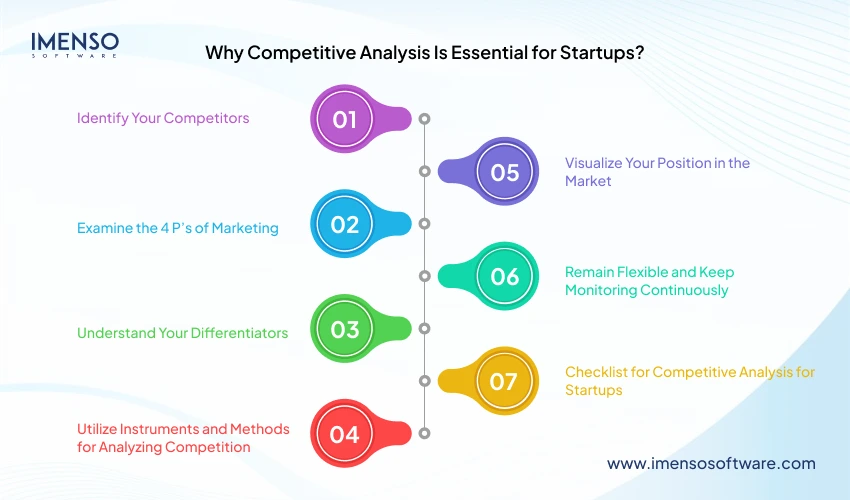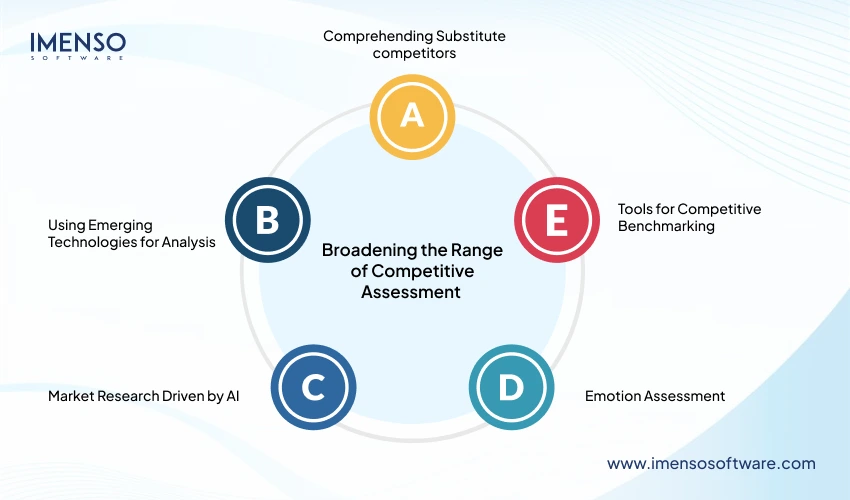How to Perform a Competitive Analysis: A Guide for Startups

Have you ever wondered how Netflix went from DVD rentals to streaming big? It all started with mastering competitive analysis. Netflix and Blockbuster were rivals in the DVD rental and video store market. However, only one of them changed with the times.
Netflix took the chance to revolutionize the market with streaming. Blockbuster held the streets with its retail domination. What was the difference? The answer is Netflix’s capacity to recognize new trends. Also to comprehend the competitive environment, and change course when necessary. However, Blockbuster was unable to do so. Do you want to learn how your startup can do the same?
Startups can stay ahead by doing a competitive analysis. Here’s how:
- Identify competitors. Look for both direct and indirect rivals.
- Analyze their strengths and weaknesses. What do they do well? Where do they fall short?
- Study their products or services. What features stand out? How are they priced?
- Check their marketing strategies. What channels do they use? What messages resonate?
- Gather customer feedback. What do users say about their offerings?
- Keep track of industry trends
Why Competitive Analysis Is Essential for Startups?

Competitive analysis is not a single task. It is an endless process that develops along with your business. Regardless of whether you’re in the research and planning phases. Maybe expanding your operations, or trying to eliminate business process bottlenecks, knowing your competitors enables you to:
- Recognize market prospects
- Enhance your value proposal
- Remain flexible in response to market developments
- Navigate through expensive errors
Steps to conduct a competitive analysis
Businesses that perform competitive research study both marketing strategies and service combinations utilized by their competitors. The research evaluates the operational strengths as well as weaknesses of these systems. Assess all available data relating to your organization along with its business sector data points. The analysis will guide you to find strategic alterations needed for your attention. Through analysis, you will establish superiority among your competitors in the market.
- Startups use particular methods to conduct their competitive analysis.
- Seek out organizations that provide related products as well as similar services.
- Review the key aspects in which competitors outshine their weaknesses and perform well.
- Determine the marketplace position through a study of competitor pricing for their products alongside the servicing of clients and administration of marketing activities.
- Check how the company presents itself on websites and how it interacts through social media channels and monitors client feedback found in online review pages.
- Your customers should talk to you about their interactions with competitor companies.
- The evaluation of upcoming industry patterns represents an essential aspect for your startup to determine its operational performance.
Business strategies benefit from useful information obtained by startups who execute these analysis steps.
Identify Your Competitors
To do a competitive analysis, first, find your direct and indirect competitors.
Direct Competitors
These are companies providing similar products or services to the same target market.
For example-
- Google versus Bing in search platforms
- McDonald’s versus Wendy’s in quick-service dining
Direct competitors are the easiest to spot. But be cautious—depending only on them may result in unintentional mimicry.
Indirect Competitors
These competitors have the same customer issue. However, they tackle it in different ways.
For example-
- A project management tool indirectly competes with paper planners or calendar applications.
Finding all customer elements and their needs helps you spot smaller competitors.
Examine the 4 P’s of Marketing
Explore your competitors more thoroughly. This can be done by analyzing the 4 P’s of marketing- Product, Price, Place, and Promotion.
1. Product
Evaluate your competitors’ products with your own. What characteristics do they have? Are there any weak points in their product that your startup can address?
2. Price
Evaluate the pricing norms, discounts, and value-for-money offers of your competitors. Are you offering a similar product for a better price or with extra benefits?
3. Place
Analyze the locations where your competitors operate and deliver their goods. Are they performing well in particular areas or markets that you could focus on?
4. Promotion
Examine how your competitors market themselves. Look at their social media use and how they interact with customers. Seek out creative concepts that connect with your intended audience.
Understand Your Differentiators
Differentiation serves as the foundation of competitive analysis. Pose two important questions to yourself:
- In what ways have you improved?
- This concerns numerical advantages.
Pace: Are quicker delivery or services available?
Cost: Are you more economical?
Efficiency: Is your approach more optimized?
Consider Apple as a case in point. They consistently emphasize quantifiable advancements. Such as extended battery life or quicker processors, with each product release.
In What Ways Are You Distinct?
This pertains to qualitative advantages. Apple’s simple design, brand history, and link to innovation distinguish it. Additional distinguishing factors could encompass:
- Distinctive branding or tone
- Different distribution channels
- Creative marketing approaches
Utilize Instruments and Methods for Analyzing Competition
Carry Out Market Research
Conduct thorough market research to grasp your competitors’ products and how customers view them. Seek solutions to these inquiries:
- Which trends are competitors taking advantage of?
- In what way do customers view their strengths and weaknesses?
Control Social Media
Check social media sites like Reddit, Quora, and Instagram. See how clients talk about your competitors. Identify shared grievances or unaddressed needs.
Visualize Your Position in the Market
A Value Proposition Map, or Perceptual Map, shows how your startup stacks up against competitors.
How to Construct a Perceptual Map:
- Select two important traits for your clients, such as cost-effectiveness and quality.
- Graph these characteristics on the X and Y axes.
- Position your competitors on the map according to their advantages.
This activity helps you spot groups of competitors and gaps in the market.
Remain Flexible and Keep Monitoring Continuously
Competitive analysis is not fixed. Markets change, and your strategy should adapt accordingly. Keep an eye on what your competitors do, what customers think, and the latest trends. Continuously assessing product market-fit helps you stay ahead.
In some cases, competitors can become partners or collaborators. This often happens in developing markets.
Checklist for Competitive Analysis for Startups
Here’s a quick checklist to keep you on track:
- Identify direct and indirect competitors
- Evaluate competitors based on the 4 P’s of marketing
- Highlight your startup’s quantitative and qualitative differentiators
- Visualize your market position with a Value Proposition Map
- Use tools like market research, social media analysis, and SEO insights
- Continuously monitor and adapt to market changes
Let’s go back to Netflix. Netflix’s CEO proposed a partnership with Blockbuster’s executives. Facing cash flow difficulties, Netflix proposed to sell itself for $50 million. Blockbuster dismissed the notion with giggles.
What provided Netflix with the advantage? In addition to technological advancement, Netflix thrived in competitive evaluation. It recognized a change in consumer tastes approving of convenience. Also, they analyzed its competitors’ shortcomings and concentrated on standing out.
Startups can learn from Netflix by honing their skills in competitive analysis and customer acquisition.
Broadening the Range of Competitive Assessment

Comprehending Substitute competitors
A type of competitor that startups frequently neglect is replacement competitors. These companies solve the same customer problem, but they use different methods or offer unrelated products.
Spotify vs. Concert Tickets: Spotify competes with other music applications. It is also competing with live events for the attention and finances of music lovers.
Uber vs. Car Ownership: Uber transformed the classic taxi sector. It has also provided an option to not own a car.
Using Emerging Technologies for Analysis
In the current rapid environment, relying solely on manual research is insufficient. Tools driven by technology can assist you in obtaining insights more quickly and with greater accuracy. Here are a few sophisticated techniques:
Market Research Driven by AI
AI tools like Crayon, SEMrush, and SimilarWeb provide quick insights into competitors. They show website traffic, SEO strategies, and online ad efforts.
Emotion Assessment
Brandwatch and Hootsuite let you monitor social media. You can also check customer feedback about your competitors. This knowledge is crucial for grasping how your audience views the competition.
Tools for Competitive Benchmarking
Services like Owler and Tableau help you quickly compare your startup’s performance with competitors. They show gaps in pricing, distribution, and customer support.
Strategies for Competitive Analysis That Foster Success

To succeed, startups require more than mere data; they need practical strategies. Let’s look at important competitive analysis techniques to help you beat your competition.
The Framework for SWOT Analysis
Strengths: Identify what makes your startup better than competitors. This could be things like advanced technology or better pricing.
Shortcomings: Acknowledge your weaknesses candidly. Utilize competitor information to identify areas where they are surpassing you.
Opportunities: Seek out market gaps or new trends that you can take advantage of.
Your business must monitor external trends that might develop into safety concerns including newly formed competitors legislative changes and altering client preferences.
SWOT analysis served as Tesla’s main organizational method for entering the market. The company employed analysis to detect operational weaknesses in traditional automotive firms which displayed slowness regarding electric vehicle development. The company invested its resources to address modern ecological requirements in the transportation sector.
Analyzing Your Competitors’ Achievements
The most helpful approach to maintaining a competitive position emerges from studying what rivals do in their operations. Through reverse engineering, Tesla examines their strategies for solution cloning as well as operational method enhancement.
Actions to Deconstruct
Through website assessment, you will learn about how customers connect with your business competitors. Sign up for their newsletters. It is important to purchase their products to view their operational methodology.
Pay attention to the procedures that drive customer acquisition along with relationship maintenance. Research their marketing operations using email messages and social media campaigns together with promotional campaign methods.
Understand products better through analysis of their pricing systems in combination with their bundled packages and fundamental features.
Focus on Customer-Centric Differentiation
A highly sustainable method to surpass your competitors is by prioritizing your customers. Instead of just copying others, focus on solving your customers’ problems in new ways.
Amazon not only established quicker delivery- it developed a whole ecosystem of advantages. They included streaming services, special offers, and ease of use. By feature prioritization catering to various customer requirements, Amazon transformed the idea of online shopping.
Establish a Competitive Intelligence Team
Startups looking to grow should build a small but dedicated competitive intelligence team. This can be a game changer.
Functions of a Competitive Intelligence Team
- Research Analysts: Gather and examine competitor information.
- Customer Insights Experts: Collect opinions and track customer feedback regarding rival companies.
- Strategic Planners: Utilize the information to create implementable strategies.
Reasons Differentiation Represents the Greatest Advantage
In busy markets, standing out is your key to success. Being “superior” might attract some clients, but being unique fosters enduring loyalty.
Instances of Differentiation:
Airbnb: Transformed travel by providing genuine local experiences rather than conventional hotel accommodations.
Glossier wants to build a beauty brand focused on community. They offer simple products and engage users through social media.
Also Read:
How to Reduce Technical Debt in Rapidly Growing Startups?
Offshore vs. Nearshore vs. Onshore Development: What’s Best for Scaling Startups?
Exploring the Future of Dot NET Development: Strategies for Hiring Top Dot NET Programmers
Identifying Your Unique Selling Points (USP)
Your unique selling point is what distinguishes you from a crowd of competitors. To locate it:
- Determine what is most important to your audience.
- Identify voids in the market.
- Align your branding, communication, and offerings to this distinct value.
- Turning Competitive Analysis Into Action
A competitive analysis holds value only when it results in practical insights. There is no way how you could transform your discovery into a winning strategy.
Once you have the data analysis spend not a lot of time on it, but focus on the core metrics for you – acquiring new customers, retaining the old customers, increasing market share, and so on.
…Experiment with new ways of doing the work and soliciting feedback; often work on methods.
Closing Words
The fast business seeks to be fast to exploit opportunities in a competitive environment.
The competitors are taking care to stay in front of us in Reflections.
Old adage of knowledge of your competition is a lot more than competitive analysis entails. That knowledge is also used for this — using it. It gives you the space to make the best decision. It creates ways of generating hidden opportunities that enable an amazing, outstanding business to grow.
For instance, think of Netflix, Tesla, and, of course, Airbnb. The more you know about the market — the more you’ll be able to identify opportunities and you will be more flexible in that respect. To know so on easy markets you want to know what your competitors are doing to succeed in business and at the same time to know exactly what you have of market share.
It’s not meant to be a piece of technology that is heart-breaking innovative compared to your competitors, it’s to be ahead of yourself and perhaps run a little smarter. If you want to stay ahead of your competitors in software fronts, contact Imenso Software. Have a look at our portfolio here!
Want more information about our services?
Similar Posts

16 Inventory Management Trends to Watch Out for in 2024
In the rapidly evolving landscape of supply chain and logistics, inventory management remains a critical component for businesses seeking to optimize their operations, reduce costs, and enhance customer satisfaction. As we step into 2024, a host of emerging trends are reshaping the way companies approach inventory management. From cutting-edge technologies to innovative strategies, let’s delve […]...

A Comprehensive Guide to Securing Seed Funding for Your Startup
Have you ever wondered where seed money for such business endeavors as Uber, Airbnb, or Zoom comes from? What did they utilize to encourage individuals to invest in their ideas and risk in their dreams? The search for seed funding can be compared with the search for the needle in the desert for the intending […]...

The Critical Role of .Net Support in Modern Application Development for Startups
Imagine a top e-commerce retailer seeing huge traffic spikes during holiday sales. The app faces a sudden surge in orders. This causes a system crash within a few minutes. This is due to weak performance and unsecured software vulnerabilities. As a result, the company loses customer satisfaction and sales revenue. This has a negative effect […]...









